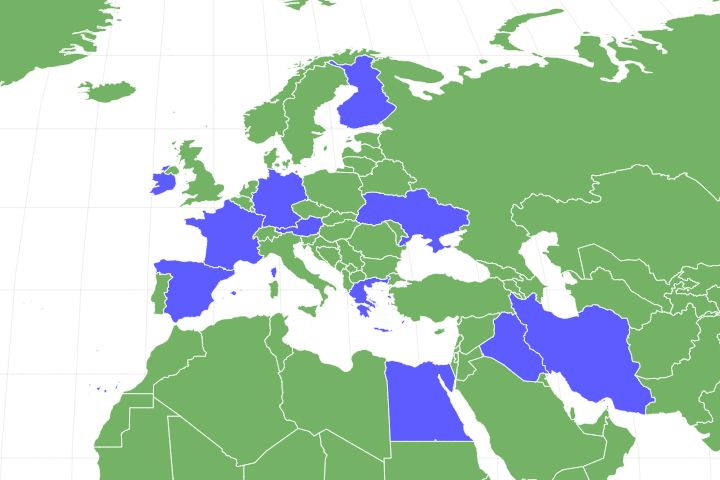Red Kite
Milvus milvus
This bird moves its tail to steer its body like a rudder on a boat.
Advertisement
Red Kite Scientific Classification
- Kingdom
- Animalia
- Phylum
- Chordata
- Class
- Aves
- Order
- Accipitriformes
- Family
- Accipitridae
- Genus
- Milvus
- Scientific Name
- Milvus milvus
Read our Complete Guide to Classification of Animals.
Red Kite Conservation Status
Red Kite Facts
- Prey
- Insects, small mammals, fish, carrion
- Fun Fact
- This bird moves its tail to steer its body like a rudder on a boat.
- Estimated Population Size
- 60,000-70,000
- Biggest Threat
- Ingesting rodents that have been poisoned
- Most Distinctive Feature
- Forked tail
- Wingspan
- 69 - 77 inches
- Incubation Period
- 31-32 days
View all of the Red Kite images!
The red kite moves its forked tail to steer itself as it flies through the air.
The first thing you notice about a red kite in flight is its distinctive forked tail. It also makes a high-pitched call that sounds similar to whistling, “weooo, weooo.” The carnivorous diet of a red kite includes small mammals and insects, but it usually eats carrion left behind on the road. It lives in Europe, Asia, and a small part of northern Africa. The wingspan of this bird is 69 to 77 inches!
3 Red Kite Amazing Facts
- Eggs in a single clutch hatch one to two days apart
- Long ago, these birds were considered pests and (mistakenly) blamed for killing small farm animals
- The oldest red kite reached 28 years old
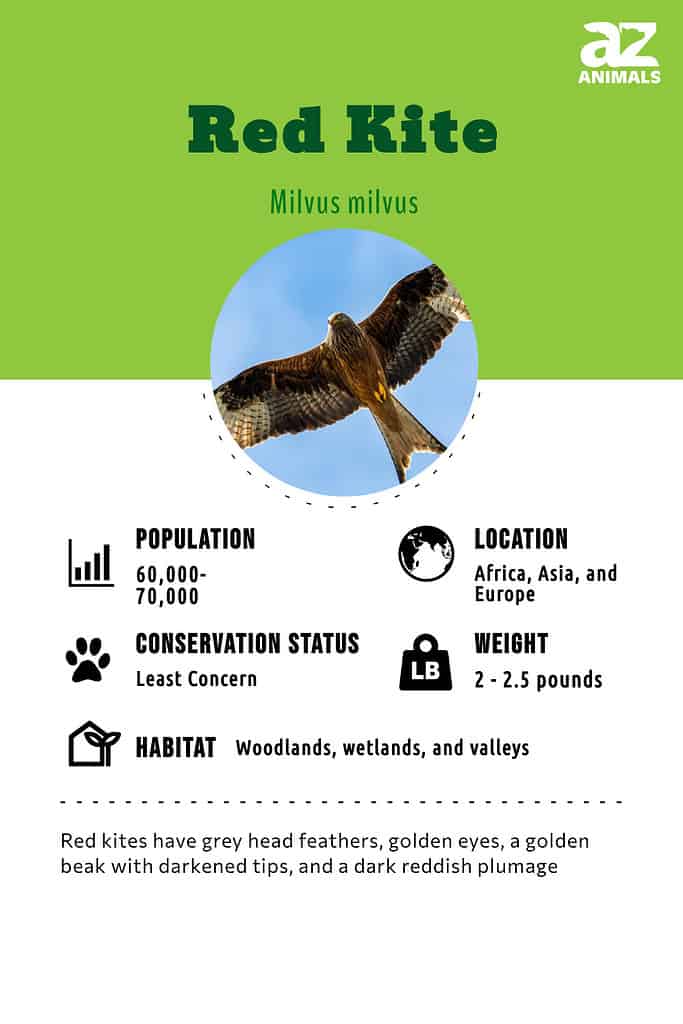
Where to Find a Red Kite
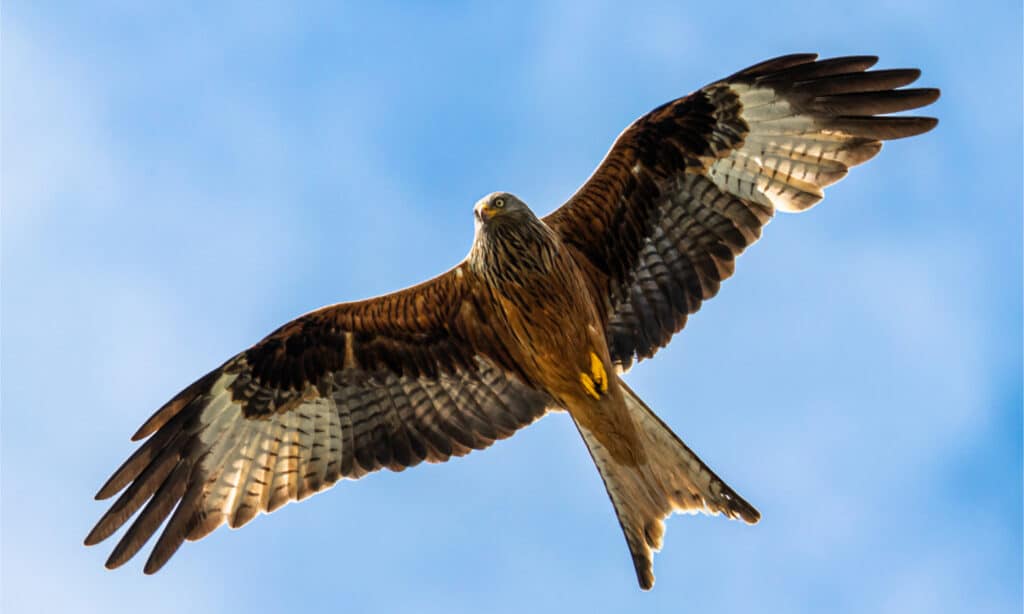
Red kites have a wingspan of 69 to 77 inches.
©Werner Baumgarten/Shutterstock.com
Red kites are found in Europe, Asia, and northern Africa. They live in a temperate climate in a variety of habitats including grasslands, wetlands, forests, and shrublands.
The best time to see these birds soaring in the sky is in the spring specifically in the month of March. They are preparing their nests for the breeding season.
Some of the countries where it’s found:
Nests
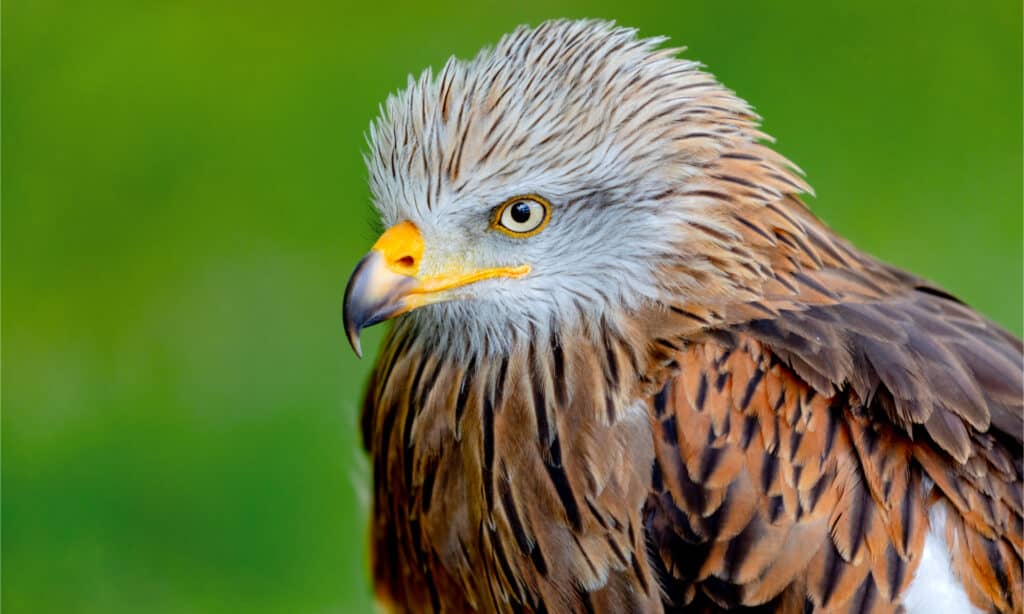
Red kites generally place their nests in tree forks placed as high as 50 feet
©Gelpi/Shutterstock.com
Sometimes red kites use nests abandoned by buzzards and other types of birds. But, if they build one, both the male and female working together.
Its nest is usually found in a tree fork located around 40 to 50 feet up in a tree. Along with large sticks, a red kite’s nest is constructed with odds and ends. This can be anything from scraps of clothing to torn paper to pieces of wool. Anything to make their baby birds feel comfortable!
Scientific Name
Milvus milvus is the red kite’s scientific name. The Latin word milvus translates to bird. In Sweden, this bird is called Glada which is the Swedish word for kite.
It belongs to the Accipitridae family and the class Aves.
Red kites belong to the genus Milvus making them the closest relatives of the other two member species of the group: black kites found in Eurasia, Australia, and Oceania, and yellow-billed kites found in Africa.
As part of the Milvinae subfamily, they are related to members of seven other genera including Mississippi kites, snail kites, slender-billed kites, and square-billed kites.
These kites all belong to the Accipitridae making them the cousins of eagles, hawks, harriers, and vultures. Members of this family date back to 50 million years ago, during the Eocene. Robust fossil evidence exists dating from the late Eocene about 35 million years ago with fossils having been discovered in America, Australia, China, England, France, and Italy.
Size, Appearance, and Behavior
Red kite birds have reddish-brown feathers on their back and breast along with a grayish-white head. Looking up at a flying red kite bird, you’ll see a large section of white feathers on the undersides of its reddish-brown wings. The underside of its forked tail is also covered in white feathers. This bird has bright yellow legs along with a hooked beak of the same color.
The forked tail of the red kite bird is not only interesting but also serves a practical purpose. The bird uses it to turn easily and swiftly in the air. This bird can dive, circle, and soar with ease. The wings of a red kite bird are notable as well. Study them closely and you’ll see they are angled at the tips. In fact, the tips of their wings have been compared to human fingertips!
This bird is 24 to 26 inches long and weighs two to two and a half pounds. Its wingspan is 69 to 77 inches.
Migration Pattern and Timing
Not all red kite birds migrate. Red kites that live in northern regions migrate south to warmer weather for the winter. For instance, red kites that breed in Germany in the springtime migrate south to France or Spain for the winter.
Types
The red kite species contains two subspecies which include:
- Milvus milvus milvus: This subspecies can be found in Africa (northwest), Europe, and the Middle East.
- Milvus milvus fasciicauda: This subspecies can be found in West Africa, in the Cape Verde Islands.
Diet
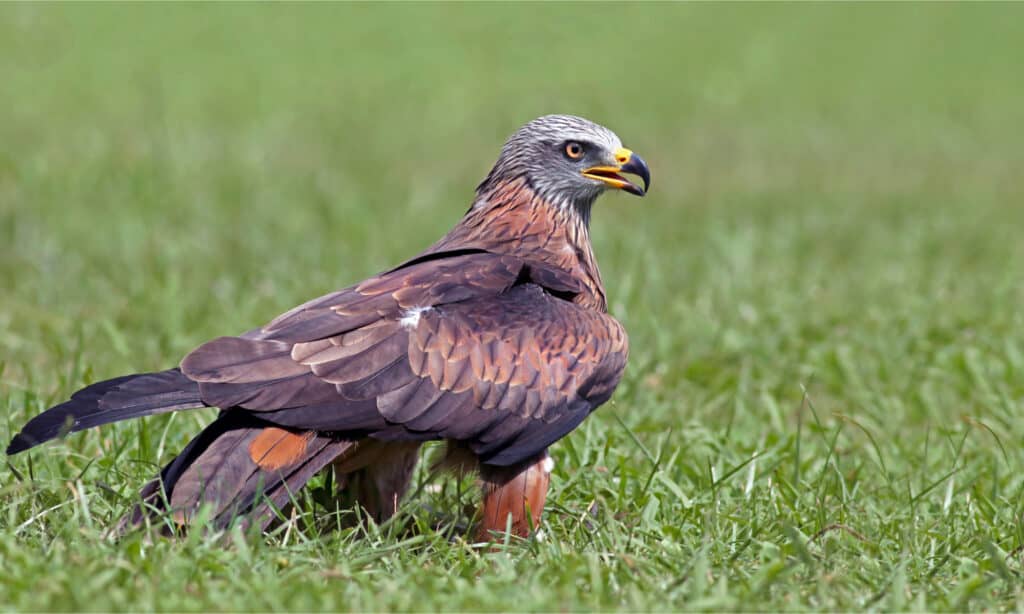
Red kites are fond of eating carrion, fish, insects, and small mammals.
©Fercast/Shutterstock.com
The red kite is a carnivorous bird. But it doesn’t always hunt its prey.
What does a red kite eat?
The red kite has a diet that includes fish, small mammals, and insects. It also eats carrion it finds on the road. Red kites have superb eyesight and agility. Consequently, they can dive and scoop their prey off the ground fairly easily.
Predators and Threats
What eats a red kite?
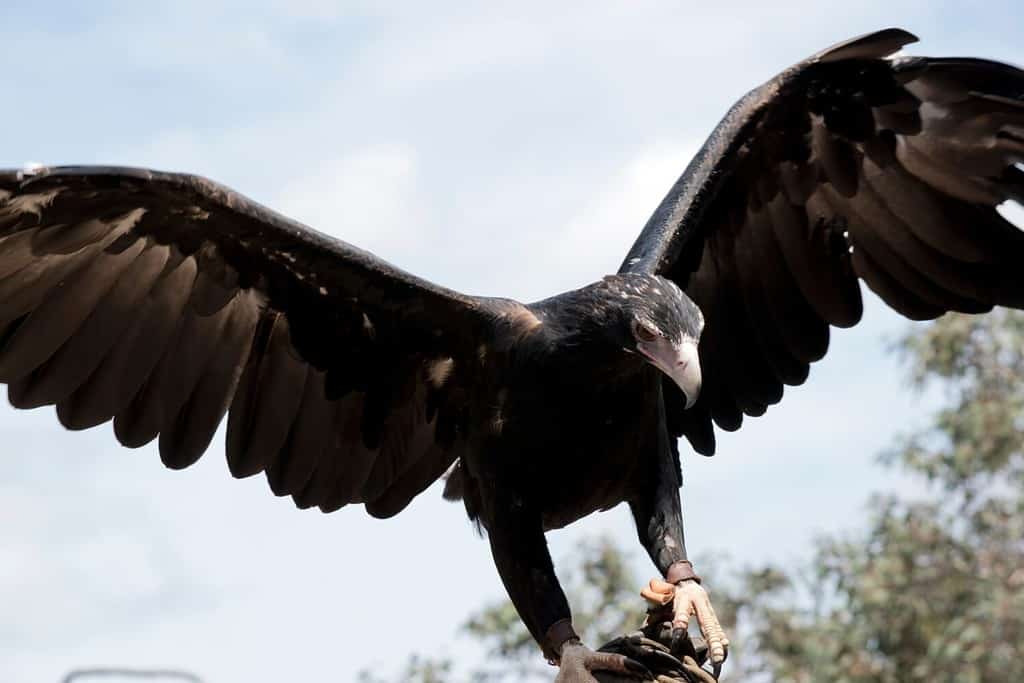
Red kits may be in danger from larger birds
©Susan Flashman/Shutterstock.com
Snakes, cats, and larger birds are predators of the red kite. However, these animals usually go after the eggs or the young of this bird.
Humans are also predators of these birds sometimes intentionally and sometimes unintentionally. For example, some farmers and others with large pieces of property, put out poison to kill mice and rats. A red kite that eats one of those dead rodents also dies from the poison.
Some people are still under the mistaken impression that red kite birds kill chickens, lambs, and other small farm animals. So, they put poison out to kill any red kites in the area. Fortunately, people are becoming more educated about this bird.
Red kites are killed when they fly into power lines, and some are hit and killed by cars when eating carrion in the road.
Despite all of these challenges, its population is increasing and is described as Least Concern on the IUCN Red List of Threatened Species.
Reproduction, Babies, and Lifespan
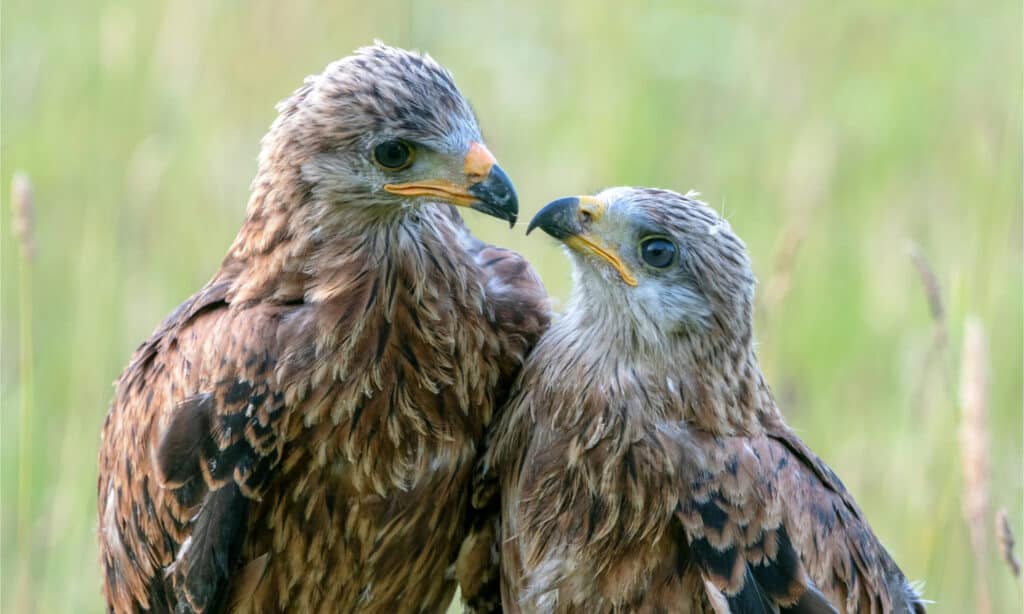
Red kite chicks leave the safety of the nest after about 3 months
©Albert Beukhof/Shutterstock.com
Spring is the breeding season of red kites. Female red kites lay one to four eggs in the middle part of April. This bird’s eggs are cream with spots of light brown. The incubation period of its eggs is 31 to 32 days. Keep in mind that the eggs hatch one or two days apart. So, one baby may be as many as two days older than another chick in the nest!
The chicks leave the nest at the age of 48 to 50 days old. But each baby usually stays around the nesting area for two or three more weeks. The parents of the chicks help to feed their young and continue to care for them during this time.
Young red kite birds are sexually mature at two to three years old. The total lifespan of this feathered creature is up to 25 years.
Population
This bird’s population of 60,000 to 70,000 is described as increasing. It’s of Least Concern.
View all 114 animals that start with RRed Kite FAQs (Frequently Asked Questions)
Does a red kite migrate?
Some red kites that breed in northern regions of Europe or Asia migrate south for the winter to enjoy areas with a warmer climate.
How many eggs does a red kite lay?
A female red kite lays one to four eggs.
How fast does a red kite fly?
It can fly as fast as 100mph.
What is a red kite’s wingspan?
Its wingspan is 69 to 77 inches.
When do red kites leave the nest?
Red kite chicks leave the nest at 48 to 50 days old. But they stay in the area another two or three weeks.
Is a red kite rare?
It’s not considered rare today. In fact, its population is growing.
What does it mean when you see a red kite?
There are lots of meanings connected to the red kite. But one common belief is it represents hope and good luck.
Are red kites and buzzards the same bird?
No. But, they do share some qualities such as a diet of carrion as well as live prey. Plus, they both have angled wings and a similar call.
One difference is a buzzard’s tailfeathers have a fan formation while a red kite’s tail is forked. A red kite also has a wider wingspan than a buzzard.
How do red kites help the environment?
Red kites help the environment by eating carrion. Also, they eat rodents and insects keeping the population of these pests under control. As you see, while they were once considered pests, red kites play an important part in maintaining a healthy environment.
Is a red kite a hawk?
No. However, they belong to the same family as hawks and are birds of prey.
Do red kites eat birds?
Sometimes. If a bird is dead on the road, a red kite may stop and eat some of it.
Thank you for reading! Have some feedback for us? Contact the AZ Animals editorial team.
Sources
- IUCN Red List, Available here: https://www.iucnredlist.org/species/22695072/181651010
- The Royal Society for the Protection of Birds, Available here: https://www.rspb.org.uk/birds-and-wildlife/wildlife-guides/bird-a-z/red-kite/
- Wikipedia, Available here: https://en.wikipedia.org/wiki/Red_kite
- Wildlife Trusts, Available here: https://www.wildlifetrusts.org/wildlife-explorer/birds/birds-prey/red-kite
- Hawk and Owl Trust, Available here: https://hawkandowltrust.org/about-birds-of-prey/red-kite
- Discover Wildlife, Available here: https://www.discoverwildlife.com/animal-facts/birds/facts-about-red-kites/
- Bird Fact, Available here: https://birdfact.com/articles/common-buzzard-or-red-kite

